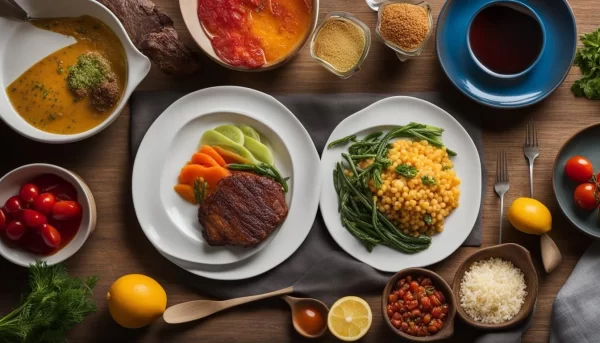The Craft of Food Pairings: Elevate Your Culinary Creations
Food pairings are an essential aspect of cooking, turning everyday meals into extraordinary experiences by blending flavors, textures, and aromas in perfect harmony. Whether you’re an expert chef or an enthusiastic home cook, mastering the art of food pairings can transform your culinary repertoire. In this blog, we’ll delve into the principles of food pairings, explore classic combinations, and inspire you to create innovative pairings in your kitchen.
The Essentials of Food Pairings:
Successful food pairings rely on the balance of complementary and contrasting flavors. Complementary flavors harmonize and enhance each other, while contrasting flavors add complexity and intrigue. Here are some foundational principles:
Harmony: Balance rich, fatty foods with acidic or bitter elements to lighten the dish. For instance, creamy Brie cheese pairs wonderfully with tart green apples or a drizzle of balsamic vinegar.
Contrast: Combine sweet with salty, spicy with cooling, and soft with crunchy for a dynamic flavor profile. A classic example is the pairing of sweet melon with salty prosciutto.
Amplification: Use ingredients that enhance the main component’s natural flavors. Herbs, spices, and umami-rich foods like soy sauce or mushrooms can elevate your dish.
Timeless Food Pairings:
Certain food pairings have become classics, cherished across cultures. Here are a few timeless combinations:
Tomato and Basil: A staple of Italian cuisine, the sweet acidity of tomatoes perfectly complements the aromatic freshness of basil.
Peanut Butter and Jelly: This nostalgic favorite balances the creamy, nutty flavor of peanut butter with the sweet, fruity taste of jelly.
Chocolate and Raspberry: The rich, bittersweet taste of chocolate is wonderfully contrasted by the tartness of raspberries, creating an indulgent dessert.
Wine and Cheese: Different cheeses have their ideal wine partners. A bold red wine like Cabernet Sauvignon pairs well with aged cheddar, while a crisp white wine like Sauvignon Blanc complements goat cheese.
Unique Pairings to Try:
Experimenting with unconventional combinations can lead to delightful culinary discoveries. Here are some unexpected pairings to inspire you:
Watermelon and Feta: The sweet juiciness of watermelon is beautifully offset by the salty, crumbly texture of feta cheese. Add fresh mint for an extra burst of flavor.
Strawberries and Balsamic Vinegar: The natural sweetness of strawberries is enhanced by the tangy complexity of balsamic vinegar. Drizzle this pairing over vanilla ice cream for a sophisticated treat.
Dark Chocolate and Blue Cheese: The intense flavor of dark chocolate pairs intriguingly with the pungent creaminess of blue cheese. Enjoy this duo with a glass of port for a unique after-dinner experience.
Avocado and Honey: The rich, buttery texture of avocado is elevated by the sweet floral notes of honey. Spread this combination on toast for a delicious and nutritious breakfast.
Tips for Crafting Your Own Pairings:
Creating your own food pairings is a fun and rewarding process. Here are some tips to help you get started:
Experiment: Be bold in trying new combinations. Taste as you go and trust your palate.
Research: Study the flavor profiles of different ingredients. Understanding basic taste elements (sweet, salty, sour, bitter, umami) can guide your pairing decisions.
Balance: Strive for a balance of flavors, textures, and colors. A well-balanced dish is visually appealing and satisfying to eat.
Seasonal Ingredients: Use fresh, seasonal ingredients to enhance your pairings. Seasonal produce often boasts peak flavor and texture.
Conclusion:
Food pairings are a vital element of cooking that can elevate your dishes from ordinary to extraordinary. By embracing the principles of harmony and contrast, experimenting with classic and innovative combinations, and trusting your taste buds, you can create meals that delight the senses. The next time you’re in the kitchen, think beyond the recipe and explore the exciting world of food pairings. Happy cooking!
FAQs:
1. What are food pairings?
Food pairings involve combining different ingredients in a dish to enhance flavors, textures, and aromas. The aim is to create a balanced or contrasting effect that elevates the overall dining experience.
2. Why are food pairings essential in cooking?
Food pairings are crucial because they can enhance the flavors of a dish, making it more enjoyable and memorable. They can highlight the best qualities of each ingredient and create a more complex and satisfying meal.
3. What principles guide successful food pairings?
The main principles include:
- Harmony: Balancing rich, fatty foods with acidic or bitter components.
- Contrast: Pairing sweet with salty, spicy with cooling, and soft with crunchy.
- Enhancement: Using ingredients that amplify the natural flavors of the main components.
4. Can you provide examples of classic food pairings?
Certainly! Here are some classic pairings:
- Tomato and Basil
- Peanut Butter and Jelly
- Chocolate and Raspberry
- Wine and Cheese
5. What are some unique food pairings worth trying?
Here are a few unconventional but delightful pairings:
- Watermelon and Feta
- Strawberries and Balsamic Vinegar
- Dark Chocolate and Blue Cheese
- Avocado and Honey
6. How can I start creating my own food pairings?
Begin by understanding the flavor profiles of various ingredients. Don’t hesitate to try new combinations and taste as you go. Researching the basic taste elements (sweet, salty, sour, bitter, umami) can also be helpful.
7. Are there any tools or resources to assist with food pairings?
Yes, several resources can help, such as:
- Flavor pairing charts
- Food pairing websites and apps
- Specialized cookbooks
- Culinary classes and workshops
8. How do seasonal ingredients impact food pairings?
Seasonal ingredients are typically at their peak in flavor and texture, making them excellent choices for food pairings. Using fresh, seasonal produce can significantly enhance the taste and appeal of your dishes.
9. What role do textures play in food pairings?
Textures add depth to food pairings. Combining different textures, such as creamy with crunchy or smooth with crispy, can make a dish more interesting and enjoyable.
10. Can food pairings affect the nutritional value of a meal?
Yes, thoughtful food pairings can improve the nutritional value of a meal. For instance, pairing foods high in vitamin C with iron-rich ingredients can enhance iron absorption. Combining healthy fats with certain vegetables can also aid in the absorption of fat-soluble vitamins.
11. How can food pairings enhance a dining experience?
Well-chosen food pairings can create balanced and harmonious flavors, making meals more enjoyable. They can also introduce new and exciting taste sensations, making dining more adventurous and memorable.
12. Do cultural influences play a role in food pairings?
Definitely. Different cultures have unique food pairing traditions based on their culinary heritage and local ingredients. Exploring these cultural pairings can expand your palate and inspire new cooking ideas.
13. How do beverages fit into food pairings?
Beverages like wine, beer, and cocktails can complement and enhance the flavors of a meal. The right drink pairing can create a more cohesive and enjoyable dining experience.
14. What are some tips for pairing wine with food?
- Match the weight of the wine with the weight of the dish (e.g., light wines with light dishes).
- Balance the acidity of the wine and food.
- Complement or contrast flavors, such as pairing a sweet wine with a salty cheese.
- Experiment with regional pairings, as local wines often pair well with local cuisine.
15. Can food pairings be useful in meal planning?
Yes, food pairings can guide meal planning by helping you create balanced and harmonious menus. Planning meals around complementary and contrasting flavors can make everyday cooking more enjoyable and nutritious.




